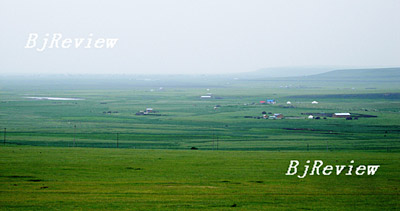
The No.6 Pasture of the Yili Industrial Group in the Inner Mongolian Autonomous Region is located 20 km from Hohhot, the region's capital city. Here, over 40 families tend more than 2,000 dairy cows introduced from the Netherlands and New Zealand. With two modern milking stations equipped with machines from Sweden, the pasture can produce 15 tons of fresh milk every day.
Cao Youtang, a local herdsman in his 40s, borrowed 300,000 yuan from relatives and friends and got 200,000 yuan in loans offered by the Yili Group in 2003. With the money he bought 30 cows and began to use the pasture where the group sells animal feed and provides training on feeding and disease prevention. At 5 a.m. and 5 p.m. every day, cows owned by herdsmen proceed to the milking stations to be milked, just like they are going to work.
Cao's family now owns 55 cows, and every cow brings in about 3,000 yuan each year. In the interim, Cao also learned about the proper ways to feed cows and implement disease prevention. "In the past when the cows were ill, I had to ride my motorbike to ask for a veterinarian, but now, I can deal with some minor illnesses myself," Cao told Beijing Review. Most of his excess profits go into buying more cows in order to reach his goal of 100.
Transformed lifestyles
Pan Gang, President of the Yili Group, freely speaks of the advantages of raising cows in the pasture. At first, the group granted loans to the herdsmen who sold milk to Yili and paid off loans with the income. Later, the group built milking stations, milking the cows separately fed by herdsmen. However, these two procedures failed to ensure the quality of the milk since some herdsman did not chose quality feed and others did not know enough about disease prevention. Now in Yili, feed is monitored and new technologies have been introduced for feeding and disease prevention, helping secure the quality of the milk.
Due to the demands of productivity, along with the aid of the government, herdsmen have gradually abandoned their traditional nomadic lifestyle. Bilige, of the Ewenki ethnic group, is a herdsman living in the Ewenki Autonomous Banner (county) of Hulunbeier City. His family has 200 hectares of grassland, 28 cows and 20 sheep. In recent years, the family erected a brick house and settled down. Besides raising livestock, they are now receiving tourists in their Mongolian style yurts and are able to tap into the stream of cars that pass by on the road in front of their home.
Breeding practices have also changed in some places. January is the coldest month in the Wuzhumuqin Grassland of Xilinguole League (prefecture), but now has become the busiest lambing season. According to Batu, a resident of the Mongolian ethnic group in Shutong Gacha (village), they used to deliver lambs in April, and most of the lambs were fully grown by September or October of the next year. Not only did this practice waste the grassland, but certain kinds of grass also damaged sheepskins, leaving them full of holes and of little value. Lambs delivered in winter can be fully grown by June of the same year when the harmful grass is not yet ripe.
In Batu's estimation, good sheepskins can be sold at 70-80 yuan per piece. Deducting expenses of delivering lambs in winter, he can make 40 yuan from every lamb. Every year, Batu's family delivers 400 lambs in winter. If these lambs are fully grown by June, the grassland can get two extra months of rest. As a lamb eats 1 kg of grass every day, the 400 lambs can save 24,000 kg of grass a year.
"Delivering lambs in winter can make more money and save grass, but we need to build warming shelters and store more grass," said Batu. "The old habit of feeding sheep just depending on nature must be changed."
Extended industrial chain
Besides traditional animal husbandry and agriculture, people in Inner Mongolia are seeking ways to upgrade the primary industrial structure. In order to do so, they have chosen to rely on the intensive processing of livestock and agricultural products. Among the 16 famous brands from Inner Mongolia, 13 are from processing of livestock and agricultural products, according to figures from the Bureau of Statistics of Inner Mongolia.
|
